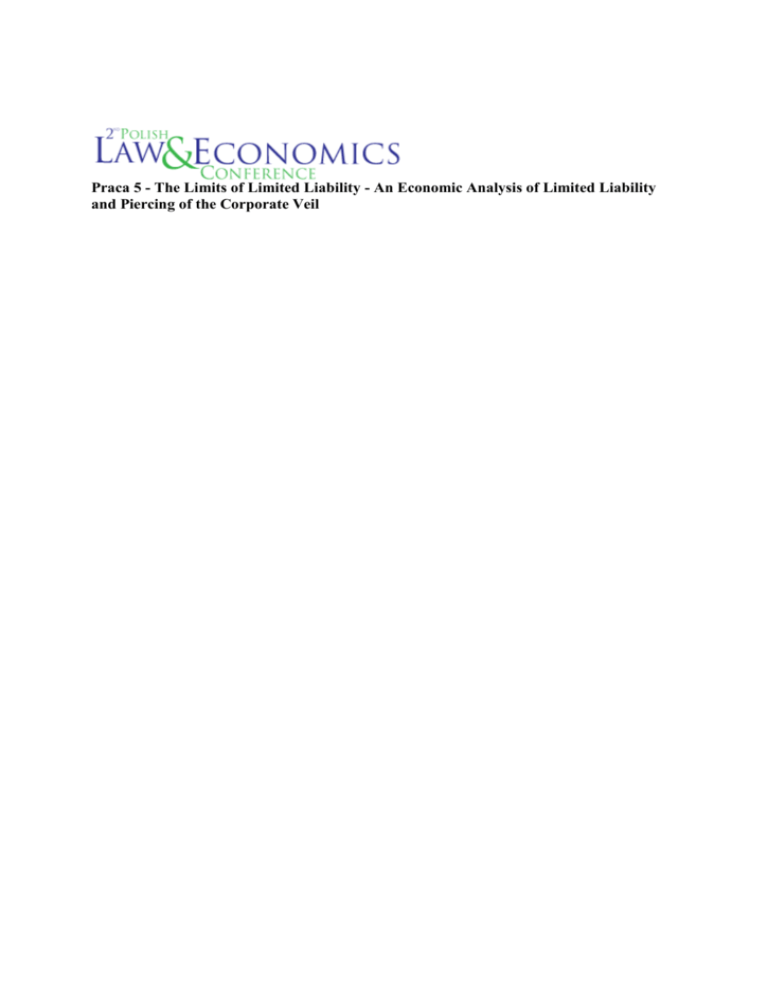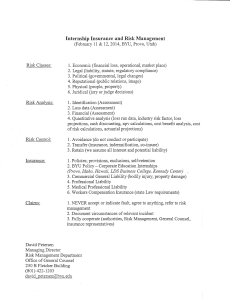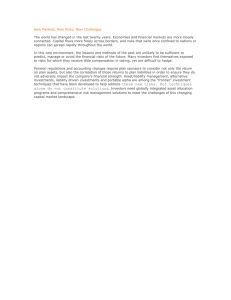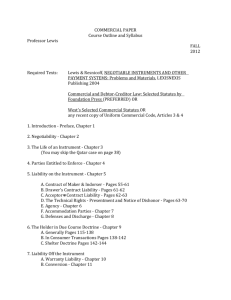
Praca 5 - The Limits of Limited Liability - An Economic Analysis of Limited Liability
and Piercing of the Corporate Veil
Contents
1. Introduction ......................................................................................................... 3
2. Limited liability – the fundamental principle of corporate law ......................... 5
2.1 General remarks ........................................................................................... 5
2.2 Limited liability as a boon to market efficiency – economic commentary .. 5
2.3 The adverse effects of limited liability ......................................................... 9
3. Piercing the corporate veil – general remarks ................................................... 13
6. Conclusion ......................................................................................................... 17
Bibliography .......................................................................................................... 18
Miłosz Jóźwiak: The Limits of Limited Liability - An Economic Analysis
1. Introduction
In the modern times the vast amount of business is performed by corporate entities whether closely held or open to the public - these legal entities, since the beginning of their
evolution in the XVII century1, have dominated the financial world, and - for better or worse extended their influence to virtually every aspect of social life. This statement does not aim to
negate or belittle the influence of mercantile policies in previous times, however it is undisputed that it was the emergence of the modern company that brought about the making of the
contemporary business world.
The modern company, as an institution of the economic reality, certainly could not
function properly without key incentive mechanisms, which provide for the maximalization of
their operational effectiveness. One of such fundamental mechanisms was traditionally established with the emergence of the principle of limited liability.2 Although this principle is all
but firmly embedded in virtually every modern legal system worldwide3, the discussion over
its scope has roots almost as deep as the principle itself. 4 Limited liability stipulates that
shareholders cannot be held personally liable for the debts of a company, whose shares they
hold.5 In this sense, shareholder liability is "limited" to the amount of their initial investment as residual claimants they are only allowed to retract their assets from a company, if the latter
is financially solvent and able to fully pay its other creditors.
1
Historically, the first stock-emitting company was the Dutch East India Company, otherwise known as the VOC
(Vereenigde Oost-Indische Compagnie), chartered in 1602 through the initiative of a group of Amsterdambased merchants. See http://www.sfu.ca/~poitras/ch2_lemaire.pdf (last visited 12.03.2011).
2
Historically, limited liability was a sovereign-granted privilege, available only to very few entrepreneurs, who
operated solely in the interest of the said sovereign. This is why corporations were not prevalent until the beginning of the 19th century. It was also during that period, when limited liability was first introduced more
broadly. A historical account of the evolution of limited liability as the fundamental principle of corporate law
may be found in O. Handlin, M. Handlin, Origins of the American Business Corporation, The Journal of Economic History, vol.5 1945, p. 1-23. Despite the title, the authors also refer to European examples.
However alien the concept of a sovereign-granted right of limited liability might seem at first glance, it is not
very different from how law operates today - the only difference being that contemporarily such a right is
given generally, hence it is no longer a privilege in a strict sense. See R.W. Hamilton, The Corporate Entity,
Texas Law Review vol. 49 (1970-1971), p. 981.
3
See eg., Articles 151 § 4 and 301 § 5 of the Polish Commercial Code (Kodeks Spółek Handlowych); Articles 64
and 175 of the Dutch Civil Code (Burgerlijk Wetboek), Articles 210 and 438 of the Belgian Company Code
(Code des sociétés/Wetboek van Vennootschappen); § 1 Sec. 1 of the German Public Company Act (Aktiengesetz) and § 13 Sec. 1-2 of the German Private Company Act (Gesetz über die Gesellschaften mit beschränkter
Haftung), or § 6.22(b) of the United States Model Business Corporation Act (2002).
4
Notes, Parent Corporation Responsibility for the Environmental Liabilities of the Subsidiary: A Search for the
Appropriate Standard, Journal of Corporation Law, vol. 19 (1993-1994), p. 773.
5
See provisions cited in supra 3.
3
Miłosz Jóźwiak: The Limits of Limited Liability - An Economic Analysis
From a global perspective, one can find an abundance of scholarly works on the legal
theory of limited liability (including empirical and economic analyses),6 however the sphere
of corporate law and its intricacies are still relatively new to the post-war Polish legal system.
Accordingly, the discussion concerning the limiting of limited liability in post-war Poland is
also fairly recent, yet it has already piqued the curiosity of a number of Polish scholars.7 The
heated debate on the reform of Polish company law spawned a proposal of amending the
Polish Commercial Code. The said proposal materialized in 2009, when the Civil Law Codification Commission put forward a project aiming to introduce a number of significant regulations of the law of corporate groups for the first time.8 Although this proposal ultimately did
not pass the legislative muster, it further fueled public debate on the desired scope of limited
liability in Poland. For the purpose of contributing to the debate, this article aims to provide a
brief economic commentary to the principal issues posed by limited liability.
Section 2 of this paper focuses on the outline of the economic incentive effects of limited liability, focusing on its key advantages and drawbacks. Section 3 provides a summary of
grounds for piercing the corporate veil,9 which aim to remedy certain threats of limited liability. Finally, Section 4 attempts to formulate certain conclusions concerning the purposefulness
of regulating the piercing of the corporate veil in the Polish legal system.
6
For an empirical analysis of piercing the corporate veil, backed by statistical data, see eg. C.L. Boyd, D. A.
Hoffman, Disputing Limited Liability, Northwestern University Law Review, vol. 104/3, 2010, p. 853-916.
7
See eg., P. Wąż, Szkoda wyrządzona przez spółkę dominującą wierzycielom spółki zależnej, Prawo Spółek
5/2008, p. 2-7; A. Opalski, M. Romanowski, O potrzebie zasadniczej reformy polskiego prawa spółek, Przegląd
Prawa Handlowego 6/2008, p. 4-11; A. Śmigaj, Odpowiedzialność spółki dominującej w prawie polskim i
włoskim, Prawo Spółek 1/2005, p. 27-34; A. Karolak, Prawne mechanizmy ochrony spółki córki oraz jej
wierzycieli w strukturze holdingowej, Prawo Spółek 5/2001, p. 2-12.
8
Draft available for download at http://bip.ms.gov.pl/pl/dzialalnosc/komisje-kodyfikacyjne/komisjakodyfikacyjna-prawa-cywilnego/ (last visited 13 III 2011). The draft did not, in fact, touch upon the specific
issue of holding a dominating company's shareholders liable for the debts of its subsidiaries. The need for
such a regulation is still disputed in Polish commercial law, see eg. P. Błaszczyk, Odpowiedzialność cywilna
spółki dominującej w projekcie nowelizacji kodeksu spółek handlowych w zakresie grup spółek (II), Przegląd
Prawa Handlowego 2010/3, p. 28, where the author argues that introducing piercing the corporate veil into
the Polish legal system would implement an entirely novel legal construct, with which the Polish judicial system is not acquainted with. The author also suggest that the ends sought through piercing the corporate veil
can be achieved by other means, such as imposing an implied obligation on the directors of a dominating
company to take into account the interests of the creditors of its subsidiaries in the decision-making process,
see Id. For an opposing view, see P. Wąż, Szkoda wyrządzona..., supra 7, where the author contends that
treating limited liability as an absolute conflicts with the principle of equity, see id., p. 2.
9
Piercing the corporate veil is a common-law term for holding the shareholders of a company liable for the
debts the company. This English legalese term has its counterparts in other languages, eg. Durchgriff in Germany, odpowiedzialność przebijająca in Poland, or doorbraak van de aansprakelijkheid in the Netherlands.
For the purposes of this article the English term will be used.
4
Miłosz Jóźwiak: The Limits of Limited Liability - An Economic Analysis
2. Limited liability – the fundamental principle
of corporate law
2.1 General remarks
Limited liability is the cornerstone principle of company law worldwide. It is based on
the notion that shareholders (investors) cannot be held liable for their company’s debts above
the sum they have contributed while purchasing their shares, or the amount that they are still
due to the company in exchange for issuing their shares.10 In other words, even if a company
is insolvent and cannot pay its debts, the shareholders’ personal assets are protected by the
“company veil”.
The principle of limited liability rests upon a more general conception of the company
as a separate entity,11 having its own assets and offices, as well as management for representation purposes, with the passive investor12 generally disinterested in the detailed affairs of the
company, relying solely on stock indices as indicators of company performance.
2.2 Limited liability as a boon to market efficiency – economic commentary
It is no exaggeration to claim that limited liability has created the stock market. A
market “player”, be it a real or juridical entity, needs to know nothing of the company whose
shares it wishes to purchase in order for its personal wealth to remain secure. One might even
devise a random mechanism for buying and selling different shares each day and the risk one
would open himself to would amount only to the money he agrees to pay for these shares
(plus the premiums of a clearing house, if any) – no more, no less. With unlimited shareholder
liability this would not be possible, hence each person willing to invest money would need to
research a great amount of variables, the vast majority of which would most likely be beyond
his researching capabilities in the first place. For example, if a company’s creditors could
come after the personal assets of any investor, a potential investor would want to research
very thoroughly not only the financial situation of a company whose shares he would like to
10
E. Werlauff, The Debtor Behind The Debtor, The Tortfeasor Behind The Tortfeasor. On Liability for another
company’s default and other debts, European Company Law 2008/5, p. 207.
11
See id.
12
The „passive investor” is a commonplace phenomenon in publicly held companies. The situation is, however,
different in so-called “closely-held companies”, whose stock is not traded on the public stock market (mostly
private companies) and whose creators (investors) often play the role of their managers. See R. Romano,
Foundations of Corporate Law, [Foundation Press: New York 1993], p. 67.
5
Miłosz Jóźwiak: The Limits of Limited Liability - An Economic Analysis
purchase, but also the financial situation of its other shareholders.13 Why so? Any paymentseeking creditor would most likely go after the shareholders with deep pockets 14 and not
waste time on company members with financial problems of their own. Consequently, a potential investor would want to know, how likely it would be that, in case of company insolvency, the company’s creditors would come after his assets, as opposed to the assets of his
fellow shareholders. To gain this knowledge an investor would need not only to inquire about
the personal wealth of other shareholders at the point of entry, but at every point in time within the duration of his investment, as the wealth of other shareholders might fluctuate to his
benefit or detriment at any time.15 This type of research would be prohibitively costly, and
most likely only a few, if any, investors would decide to incur such enormous costs. In addition, the bigger the company and the more shareholders it would have, the costs of such continuous research would be elevated accordingly, thus providing negative incentives for large
companies to exist.16 It is hence argued that limited liability promotes monitoring cost efficiency, as it transfers all these costs to corporate creditors who are more cost-effective at
monitoring corporate solvency, since they only need to appreciate the risk of insolvency at the
moment of contracting with a corporation, setting the contract terms (i.e. price, interest, wage
rates, credit, etc.) accordingly.17
In a limited liability regime the risk of a corporate debtor defaulting is borne by the
creditors. As mentioned in the preceding paragraph, these risks can be appreciated in voluntary transactions, hence contract terms can be adjusted accordingly. This does not mean that
in all contractual transactions risk appreciation will always take the form of a shift of the exchange rate balance in favor of the risk-bearing party. In practice such adjustments are often
materialized in the form of restrictive covenants or trust indentures, which shift some of the
risk back to the corporate debtor and allow the contract price to remain at a steady level,
hence firms seeking credit can acquire debt funding at a lower yield. 18 In other words, limited
13
P. Halpern, M. Trebilcock, S. Turnbull, An Economic Analysis of Limited Liability in Corporation Law, University
of Toronto Law Journal, vol. 117 (1980), p.136.
14
P. I. Blumberg, Limited Liability and Corporate Groups, Journal of Corporation Law, vol. 11 (1985-1986), p.
614.
15
Id.
16
See R. Romano, Foundations of..., supra 12, p. 72.
17
See Halpern, Trebilcock, Turnbull, An Economic Analysis..., supra 13, p. 124. Please note that this argument is
valid only in cases of voluntary transactions. See infra notes 33-36 and accompanying text for further details.
18
See T. H. Jackson, A. T. Kronman, Secured Financing and Priorities Among Creditors, Yale Law Journal, vol. 88
(1979), p. 1143. Please note that some of the examples invoked by the authors cannot be directly transplanted into other legal systems. E.g., mortgage in the Polish system does not allow for an extra-judicial form of
execution, while in the U.S. system - it does. As a consequence, collection costs would presumably be much
lower in the latter system. For other examples of secured transaction and their influence on contract price,
6
Miłosz Jóźwiak: The Limits of Limited Liability - An Economic Analysis
liability plays a significant role in opening up the market of debt financing - this is beneficial
for the credit demand and supply sides both.
In an unlimited liability regime, an alternative for the shareholders of a company
would be to contract around unlimited liability, i.e. in each and every transaction a given
company would need to negotiate with the other party the essential provisions on protection
of personal assets of the company’s shareholders. Ultimately, the effects of such a procedure
would most likely resemble those achieved with limited liability,19 however this is only true in
case of voluntary transactions. Contracting ex ante around unlimited liability would be impossible, for instance, in cases of tort liability.20 A different solution might be shareholder insurance, however it would most likely be impossible to agree on an optimal level of insurance
with different amounts of shares held by respective shareholders – a “larger” shareholder
would benefit more from a hefty insurance than a “smaller” one, since the insurance interest
of the former would be proportionately larger.21 Limited liability not only makes free transfer
of shares possible and allows the open market to exist, but also reduces the costs of monitoring the company and its shareholders, which otherwise would need to be incurred by investors.
Therefore, it is a well established conclusion, that without limited liability, publicly held corporations with numerous small shareholders could not exist22.
Limited liability provides incentives for investors to diversify their portfolios. Without
limited liability, investors would incur monitoring costs so high, that investing in multiple
companies would be impossible. As a corollary, limited liability makes the investment market
more liquid, making it easier for companies to find numerous smaller investors and maximize
their production value.23
see id. It also vital to note that conduct-restraining covenants of all sorts generate monitoring costs themselves, hence they are by no means a perfect security of a creditor's interest.
19
This contention is only true in case of legal systems in which contract law would allow for such stipulations. If
this requirement is met, the process of contracting around might introduce negligible costs, see R. E. Meiners,
J. S. Mofsky, R. D. Tollison, Piercing the veil of Limited Liability, Delaware Journal of Corporate Law, vol. 4
(1979), p. 364. The authors hold that minimalization of costs can easily be achieved through the use of standardized contracts. This would, according to the authors, eliminate the costs of tailoring each and every
agreement to the needs of every transaction.
20
The division of creditors into voluntary (e.g. contract) and involuntary (e.g. tort) is not as much disputed, as
the influence it has on the difference in economic position of the members of these separate groups. This argument will be expanded in part 2.3 of this article, see infra notes 34-38 and accompanying text.
21
R. Romano, Foundations of..., supra 12, p. 73. In addition, agreeing on a separate insurance policy for each
shareholder in a market of fluctuating ownership would be impossible.
22
H. G. Manne, Our Two Corporation Systems: Law and Economics, 53 Virginia Law Review 1967, p. 262.
23
See P. I. Blumberg, Limited Liability and..., supra 14, p. 616.
7
Miłosz Jóźwiak: The Limits of Limited Liability - An Economic Analysis
"Insured" from personal liability, company managers undertake projects, which otherwise might be deemed too risky. Most people, including managers, are considered risk-averse
when dealing with their personal affairs, and limited liability separates those affairs from the
affairs of the company, thus reducing the strength of constraints imposed by risk aversion on
managers. With unlimited liability, managers (including controlling shareholders) would most
likely not engage in projects, which might very well have a significant positive net value24. As
a consequence, society as a whole may benefit from an increased production volume, as well
as an optimized level of research and development - especially in experimental fields, which
carry only a slight probability of success, but at the same time have an expected value outweighing the risks, if successful. 25
Furthermore, limited liability makes it possible for the prices of shares to reflect the
overall financial situation of a company more precisely26. If each and every shareholder was
held personally liable for a company’s debts, the price of shares would be highly dependent
on the personal welfare of the shareholders, as opposed to the performance of the company.
Finally, from a creditor’s point of view, limited liability reduces collection costs, since
creditors do not need to bring individual law suits against each of the company’s shareholders.
Some authors claim that in an unlimited liability regime, the costs of the judicial proceedings
would be so high as to deter from employing the court mechanism completely. 27 In addition,
creditors need not incur costs of acquiring information on the financial situation of the company’s shareholders prior to making the decision, whether or not to trade with a certain company.28
24
The general formula for computing the expected value of an investment may be found in: R. Cooter, T. Ulen,
Law & Economics, 5th ed. [Pearson Addison Wesley 2008], at 48. An explanatory example may be observed in
experimental sciences, where a researched medicine or invention may have a very high monetary value when
developed, with a very low probability of success of the research. In a standard risk-aversion setting, no rational investor would fund such a research. See further D. W. Leebron, Limited Liability, Tort Victims, And
Creditors, Columbia Law Review, vol. 91 (1991), p. 1570 et seq.
25
See P. I. Blumberg, Limited Liability and..., supra 14, p. 616.
26
F. H. Easterbrook, D. R. Fischel, Limited Liability and the Corporation, 52 University of Chicago Law Review 89
(1985), p. 96.
27
See R. E. Meiners, J. S. Mofsky, R. D. Tollison, Piercing the veil..., supra 19, p. 363. The authors point especially
to the issue of litigation costs involved when bringing an action against multiple shareholders in multiple jurisdictions and venues. See id.
28
As stated above, these costs can easily be eliminated through contracting around limited liability with the use
of standardized agreements. See supra 19 and accompanying text.
8
Miłosz Jóźwiak: The Limits of Limited Liability - An Economic Analysis
To sum up, the following quote by Professor N.M. Butler of Columbia University does
justice to the principle of limited liability as the foundation of modern corporate law and the
contemporary financial market as we know it:
“The limited liability corporation is the greatest single discovery of modern times.
Even steam and electricity are less important than the limited liability company.”29
2.3 The adverse effects of limited liability
As is true in virtually every sphere of economics, ideal solutions do not exist, especially if one is attempting to find such solutions in absolutes. One of such absolutes is undeniably
the unconditional reverence for limited liability, which does pose certain threats.
The corporate structure is classically qualified as a generator of perhaps one of the
most mainstream dilemmas in economics - the principal-agent problem. This article does not
aim to analyze or dissect the traditional form of the conflict of interests stemming from the
relations between corporate managers and owners (shareholders). 30 Not surprisingly, the
broad category of limited liability could not escape the agency problem. The company veil,
while shielding the shareholders of a debt-incurring company from liability, shifts the risk of
default to the creditors, hence - to an extent - it is the creditors who become "principals" of
company shareholders,31 the latter acting as "agents" of the former.
The aforementioned risk shift is often branded as the “externality problem”32: because
equity owners reap all the benefits of risky projects and share the losses with the creditors of
their company, corporations are deemed to take more risk than economic efficiency might
dictate. As a consequence, shareholders of a company receive strong incentives to shift the
29
Quoted by J. Dine, M. Koutsias, Company Law, 6th ed. [Palgrave Macmillan: New York 2007], p. 1.
Agency theory is one of the cornerstone concepts in microeconomics theory. It rests on the assumption that
a principal's wealth is governed by an agent, the latter having an information advantage in terms of the status
of the governed wealth (this is referred to as the asymmetric information problem). Agency problems permeate the world of legal relations, the most common examples being relationships between trustees and trustors, commercial banks and depositors, or investment banks and securities purchasers. For an in-depth coverage of the agency theory with reference to financial markets, see F. S. Mishkin, The Economics of Money,
Banking and Financial Markets, Business School Edition [Pearson: 2010], p. 174 et seq.
31
One must bear in mind that not all shareholders can be treated as agents in such a construct, as it is only the
controlling shareholders that can decisively influence the solvency of the debtor-company. Even this, however, is not always true, as experience has shown that more often than not the "dominating" force comes from
shadow directors or de facto directors, who often do not hold any stake in the debt-incurring company.
32
R. Romano, Foundations of..., supra 12, p. 62.
30
9
Miłosz Jóźwiak: The Limits of Limited Liability - An Economic Analysis
costs of risky operations to their creditors (moral hazard within a company).33 Creditors dealing voluntarily with a company in such a setting would most likely include the increased risk
in the contract price or by way of forming other contract terms in their own favour. Still, involuntary creditors have no such opportunity to contract around the risk imposed by limited
liability. Yet even the standing of voluntary creditors may not be as transparent as some
would imagine. Jonathan Landers argues that the assumption that voluntary creditors will appreciate the risk of insolvency of the debt-incurring company and use that knowledge to negotiate contractual terms accordingly is all but idealistic.34 The author notes that the class of
voluntary creditors is far from uniform, as some members of the group will inquire on the
solvency of the debtor, some of them will consciously refrain from making such queries,
while the rest will simply lack the resources or the expertise to carry out the research. Out of
the three, only the first sub-group fits into the idealistic notion of the full appreciation of risk
by creditors.35 In addition, even if one assumes that the entire group of voluntary creditors
should be barred from piercing the corporate veil simply because of the fact of their having an
opportunity to inquire into the solvency of their debtors (regardless of actually having utilized
this opportunity or being in a negotiating position strong enough to make demands), one must
not oversee the moral hazard problem.36 According to this behavioral theory, subsequent to an
insurance transaction, an insuree's behavior changes, since his actions are no longer constrained by a perspective of loss. In effect, the risk of the event insured against significantly
rises, but the insurance premium remains at a low level, because it was calculated at the moment of contract making. This dilemma is analogous to what happens under limited liability once contract terms with a creditor are set, there is a strong incentive for the controlling
shareholder(s) to engage in riskier activities, while limited liability "insures" them against
losses above their original investments, externalizing the risk of such loss to the creditors.
Notwithstanding the above remarks, the group of “involuntary creditors” is still uniformly the most threatened category of creditors, bearing the burden of a large portion of
33
F. H. Easterbrook, D. R. Fischel, Limited Liability..., supra 26, p. 104. In this sense, limited liability operates as
a sui generis implied insurance mechanism, with all the negative microeconomic effects of insurance, including negative selection and moral hazard.
34
Jonathan M. Landers, A Unified Approach To Parent, Subsidiary, and Affiliate Questions in Bankruptcy, University of Chicago Law Review, vol. 42 (1975), p. 596.
35
See id.
36
For an insurance-oriented explanation of the moral hazard dilemma, as well as some popular insurancepolicy remedies, see R. Cooter, T. Ulen, Law..., supra 24, p. 53.
10
Miłosz Jóźwiak: The Limits of Limited Liability - An Economic Analysis
externalized costs.37 This group, in its widest scope, could include not only tort victims, but
also the employees of a company, as well as more abstract categories, such as the environment or state policy.38 The rationale for the voluntary-involuntary division lies largely within
the moral hazard problem. As opposed to contract dealings, in which the dilemma arises only
subsequently to the making of a contract, in tort moral hazard exists virtually from the very
outset of a company's existence, hence the efficiency problem is that more severe. 39 The dividing line becomes more blurry when dealing with misrepresentation or fraud, where the
contracting creditor cannot effectively price the risk due to his misinformation - in such cases,
it is argued, the distinction does not hold.40
Limited liability creates further issues pertaining exclusively to groups of corporations.41 It is established that profit-maximizing investors in a group of companies may care
little for the interests of individual companies within a group, as long as the return of the
group as a whole is maximized.42 As a consequence, stakeholders of a single company, whose
37
"Involuntary creditors", as a class, is not defined identically by all authors, as some understand it to include
only those creditors, who do not even have the formal opportunity to appreciate the risk beforehand (the
narrow understanding), while some define its scope somewhat broader - including consumers and employees
of corporations, who are faced merely with a take-it-or-leave-it choice when dealing with a corporate debtor.
See e.g. H. Hansmann, R. Kraakman, Toward Unlimited Shareholder Liability for Corporate Torts, Yale Law
Journal vol. 100 (1991), p. 1920, where the authors adopt the narrow view.
38
A telling example of how cost externalization works in tort cases may be found in a U.S. case Walkovszky v.
Carlton, 223 N.E.2d 6 (1966), where the plaintiff was severely injured when run down by a negligently operated taxicab in New York. The cab belonged to a company, the assets of which roughly consisted of two taxicabs insured for a minimum sum of $10,000 each, which was insufficient to cover the plaintiff's damages. The
company, however, was part of a larger corporate group, which consisted of a number of similar two-cab
companies. Despite the plaintiff's request for piercing the corporate veil, the court denied relief. See id.
39
F. H. Easterbrook, D. R. Fischel, Limited Liability..., supra 26, p. 112. The authors claim that contract creditors
are compensated ex ante for the increased risk of default ex post, while tort creditors are not compensated at
all. In light of the preceding paragraph of this article, this division is not as vivid as it may seem.
40
See R. A. Posner, The Rights of Creditors of Affiliated Corporations, University of Chicago Law Review, vol. 43
(1976), p. 520-524, where the author thoroughly describes the asymmetric information problems raised by
misrepresentations of debtors. The author also explains the taxicab problem, id., p. 519-520.
41
It is essential to note that historically, the advent of limited liability as a general principle took place in a
business world vastly different from the contemporary one: corporate shareholders almost never engaged in
the day-to-day management of their companies (there was little to no overlap between managers and shareholders), and secondly - corporations were not allowed to hold stock in other corporations. See P. I. Blumberg,
The Transformation of Modern Corporation Law: The Law of Corporate Groups, Connecticut Law Review vol.
37 (2005), p. 607. In general, the need for corporate groups did not emerge until the industrial revolution.
Corporations as shareholders were, however, not treated differently from individuals, hence limited liability
shielded all shareholders from liability and this status has generally persisted until today.
42
Note, Subsidiary Corporations and Credit Manipulation, Harvard Law Review vol. 41 (1928), p. 889-891. The
author invokes the example of bondholders of a subsidiary company, which - subsequent to the issuance of
the bonds - has its assets siphoned away by the parent. In such a case the market value of the bonds would
undoubtedly plummet. Even if the bond interest was adjustable, it is doubtful whether the "paper form" subsidiary would be in possession of any assets to cover a higher rate note.
11
Miłosz Jóźwiak: The Limits of Limited Liability - An Economic Analysis
assets are, for instance, siphoned away for the benefit of the group, may find themselves in a
difficult situation. 43 Furthermore, creditors of companies belonging to a group may need to
incur additional monitoring costs of the members of a group, since market ratings may reflect
only the performance of the group as a whole, leaving hidden the distribution of wealth and
profits within a group.
While the above adverse effects of limited liability mostly jeopardize the interests of
corporate creditors, the following wide category of negative effects creates substantial threats
largely outside the corporate structure. The principle of limited liability may, under certain
circumstances, create strong incentives for regulatory tourism.44 The issue of large corporate
groups creating subsidiary entities in jurisdictions with "weak" regulatory regimes is by no
means novel, however certain loopholes in seemingly "strong" jurisdictions may leave exploitable room for corporations to bypass national norms without having to cross national
borders.45 Such was the issue in the case of Enron, which constituted perhaps one of the most
infamous examples of employing abundant corporate subsidiaries as a means of evading national accounting regulations.46 Arguably, the most prevalent cases of abuse of the corporate
form include issues of cross-border liability of parent companies for torts or statutory violations of their subsidiaries. These events are often the cause of a major public outcry against
the corporate world and receive a substantial amount of media coverage. More often than not,
allegations of both environmental and human rights violations are involved in a single case.47
In Doe v. Unocal48 the defendant, a California-based company, was sued by the villagers of
Tenasserim (Myanmar) for human rights violations committed by the government of Myan43
J. M. Landers, A Unified Approach To Parent, Subsidiary, And Affiliate Questions in Bankruptcy, 42 The University of Chicago Law Review 1975/4, p. 591-592.
44
For the purposes of this article, the term "regulatory tourism" will be used while referring to any actions
aimed at circumventing national laws enacted for the benefit of the general public by means of incorporating
subsidiaries in other jurisdictions.
45
In certain jurisdictions reaching a statute-specified number of shareholders or a set volume of issued capital
triggers a more rigid regulatory regime applying to a given company. For instance, in the Netherlands, public
companies are classified into two categories: "ordinary" and "large" public companies. Large public companies (structuur vennootschappen) are subject to a special regulatory regime, which - among others - grants
extended powers to supervisory boards. To prevent circumventions, in classifying a company into one of the
categories, the Dutch Civil Code takes its subsidiaries into account. See M. Andenas, F. Wooldridge, European
Comparative Company Law [Cambridge University Press: 2009], p. 368 et seq.
46
S. L. Schwarcz, Enron and The Use and Abuse of Special Purpose Entities in Corporate Structures, University of
Cincinnati Law Review 2002/4, p. 1309-1318. This case is invoked here as an example of abuse, not as a
means of evading liability: in the case of Enron illegitimate conduct ultimately destroyed the entire group.
47
For an extensive list of litigation concerning human rights violations of multinational corporate groups, see
http://www.law.monash.edu.au/castancentre/projects/mchr/trans-hr-litigation.html (last visited 19 III 2011).
48
Doe v. Unocal Corp, 403 F.3d 708 (9th Cir. 2005).
12
Miłosz Jóźwiak: The Limits of Limited Liability - An Economic Analysis
mar, with whom Unocal was in a joint venture agreement for the construction of the Yadana
pipeline. Even though Unocal operated in Myanmar through a fourth-tier subsidiary, the villagers attempted to sue the parent company in California. The claim was ultimately settled,
however not before a state trial court denied relief against the parent company in California,
rejecting the arguments for piercing the corporate veil.49 In 1984 an environmental catastrophe brought a death toll of between two and ten thousand in Bhopal, India, when a pesticide
plant owned by Union Carbide of India (a subsidiary of Union Carbide Corp., U.S.-based)
leaked hazardous chemicals into the countryside.50 An example of the two issues intermingling also arose recently in Europe, as citizens of Nigeria sued Royal Dutch Shell, an oil
company based in the UK and the Netherlands, for environmental damages caused by its subsidiary, Shell Nigeria.51 The above issues may be more generally referred to as problems of
abuse of the corporate form. It is worth noting that the potential for cost externalization in the
field is all but limitless - the examples invoked above serve merely a signaling purpose.
3. Piercing the corporate veil – general remarks
As argued in the previous section, from an efficiency perspective, limited liability can
generate adverse effects not only to the economy, but to social welfare as a whole. It is not
disputed that limited liability is and should remain a principle of modern corporate law, however, in specific narrowly-tailored circumstances, the limits of limited liability should be observed. It is the purpose of this section to analyze cases in which corporate-veil piercing may
be justified in terms of economic efficiency.52 However, before moving on to the analysis,
three further remarks need to be made. The concept of remedying the drawbacks of limited
liability through shareholder liability does not indiscriminately abolish limited liability as ap-
49
For an analysis of the litigation, see A. Rosencranz, D. Louk, Doe v. Unocal: Holding Corporations Liable for
Human Rights Abuses on Their Watch, Chapman Law Review, vol. 8 (2005), p. 135-152.
50
M. Dearborn, Enterprise Liability: Reviewing and Revitalizing Liability for Corporate Groups, California Law
Review vol. 97 (2009), p. 227.
51
The procedural history of this case was of a specific nature, as the plaintiffs sued the parent, Royal Dutch
Shell, before a Dutch court, arguing that the rule of law was more reliable in Europe. See
http://news.bbc.co.uk/2/hi/8434736.stm (last visited 20 III 2011). This is a classic example of piercing the
corporate veil for jurisdictional purposes, which is a legal issue in its own right. See J.A. Schwarz, Piercing the
Corporate Veil of an Alien Parent for Jurisdictional Purposes: A Proposal for a Standard that Comports with
Due Process, California Law Review vol. 96 (2008), p. 731-763.
52
In terms of economic theory, the author of this article does not believe that Pareto efficiency is achievable in
any case where numerous contradicting variables are involved, as is the case with piercing of the corporate
veil. A more pragmatic approach points towards a weaker version of improvement efficiency: Kaldor-Hicks
efficiency, which is more likely to be achieved in such cases. For an explanation of the economics of improvement, see R. Cooter, T. Ulen, Law..., supra 24, p. 47-48.
13
Miłosz Jóźwiak: The Limits of Limited Liability - An Economic Analysis
plied to all shareholders of a company - influential or no. It is therefore a mistake to claim that
piercing the corporate veil might dissuade small investors from purchasing company shares.53
Secondly, the constraints of this article do not allow for a complete analysis of every possible
veil-piercing ground - jurisdictions worldwide have adopted their own approaches to the issue,
with some of them enacting statutes outlining the necessary conditions for veil-piercing, some
tending to leave such determination to the courts, while others tend to ignore the issue completely and cling to the traditional reverence for limited liability.54 The Polish system seems to
fall into the last category.55 Finally, while arguing either for or against limiting limited liability, one should take into account that most of the deliberated legal constructs are not examined in a theoretical vacuum. For instance, shifting the risk of default to creditors need not
necessarily create market inefficiencies, as contemporarily it is the creditors who bear direct
default risk in the field of private equity, 56 and the market seems to be functioning well.
While considering potential grounds for piercing the corporate veil, it is vital to note
that contract defaults and torts are not an anomaly in the business world 57 - bankruptcies often
happen with no direct fault on the part of wound-up companies, such as torts cannot always be
traced to illegitimate conduct from within the corporate structure. Consequently, transferring
risk to corporate shareholders must not happen too readily, and should always include a faultrelated element.
The limiting of limited liability should be seriously considered in cases, where the
shareholders of a company are attempting to use the corporate form to extract value from other parties, while not paying them for it.58 Such situations may be classified as uncompensated
transfers of wealth, and it is inequitable and inefficient to deprive one of wealth, which he
53
It follows that "unlimited liability" should be differentiated from "enterprise liability". The latter imposes
liability for company affairs merely on specific, not all, shareholders. See e.g. M. Dearborn, Enterprise Liability..., supra 50, p. 200.
54
For a comprehensive comparative overview of piercing the corporate veil in a number of European countries
and the United States, see K. Vandekerckhove, Piercing The Corporate Veil, [2007 Kluwer Law International].
55
Although there are certain provisions of Polish statutory law which could potentially enable veil-piercing
actions, such as article 527 (actio Pauliana) of the Polish Civil Code, such attempts have not been made.
56
This is not entirely true, as private equity often functions as a multi-tiered model of financing, in which the
direct creditors of a private company (or a start-up, in the case of venture capital) obtain funds from other
investors, and it is these investors who ultimately bear the risk. The argument, however, proves that creditors
often can effectively monitor the risks of insolvency of their corporate debtors. This, of course, comes with
the caveat that private equity creditors are specialized entities, equipped with the necessary tools and expertise for risk-monitoring operations.
57
D. Millon, Piercing the Corporate Veil, Financial Responsibility, and the Limits of Limited Liability, Emory Law
Journal vo. 56 (2007), p. 1341. The author refers to such occurrences as "ordinary business failures."
58
See Id., p. 1349.
14
Miłosz Jóźwiak: The Limits of Limited Liability - An Economic Analysis
does not willingly relinquish.59 In this context, it is proposed to divide corporate borrowers
into "good" borrowers, who take the interest of their creditors into account, and "bad" borrowers, who seek exploitable creditors. In such a setting, comparisons between the corporate
theory and the theory of insurance seem to arise. Accordingly, since creditors often do not
incur monitoring costs high enough to screen the "bad" borrowers and distinguish them from
the "good" ones, they adjust their offering rates for the bulk of corporate borrowers, and - as a
consequence - it is the "good" borrowers that suffer losses, since they are forced to pay a
higher premium, than their credit standing would dictate.60 In these circumstances, if limited
liability were not to operate in cases of shareholder opportunism, thus implying a personal
shareholder guarantee whenever a controlling shareholder abuses the corporate form, the costs
of credit might decrease as a result.61
Leaving aside the country-specific nature of veil-piercing grounds, 62 in general the
remedies to the above-stated dilemma are at times referred to as "equitable grounds", and include misrepresentation, asset siphoning and fraud. It is often the case that certain additional
grounds are differentiated form the principal ones mentioned, e.g. the abuse of company name,
which may very well be classified as falling into the broader "misrepresentation" category.63
Fraud is arguably the most paramount ground for holding shareholders liable.64 Most
importantly, fraud is not a criterion in itself, but is always linked with certain conduct, e.g. the
siphoning of assets away from a subsidiary to a parent, which triggers the insolvency of the
subsidiary.65 The weight of fraud as a decisive factor in deciding veil-piercing cases is offset
by the heavy burden of proof placed on the plaintiff, as proving the fault of a shareholder of a
parent corporation is extremely difficult. As a suggestion, introducing a presumption of illegitimate conduct, shifting the burden of proof onto the defendant, might prove a cost-reducer,
since it is the enterprise that has comparatively better access to evidence in such cases.
59
Id.
See id., p. 1353. Following the terminology of the theory of economics of insurance, this dilemma could be
referred to as the adverse selection problem in limited liability.
61
Id., p. 1354. The author points out that for such an effect to take place, a precise veil-piercing set of criteria
would need to exist, so as to ensure the predictability of outcomes.
62
In certain jurisdictions these criteria are tailored more narrowly than in others. For instance, veil-piercing is
allowed sparingly in the UK, with fraud being the sole relevant ground, as opposed to the United States,
where a broader set of grounds are allowed. See K. Vandekerckhove, Piercing..., supra 54.
63
This is principally a terminology issue and does not have much bearing on the subject at hand.
64
Even in the UK, which is considered one of the most conservative jurisdictions in veil-piercing cases, this
ground is widely recognized. See J. Payne, Lifting the corporate veil: A reassessment of the fraud exception,
Cambridge Law Journal 1997/2, p. 284.
65
K. Vandekerckhove, Piercing..., supra 54, p. 71.
60
15
Miłosz Jóźwiak: The Limits of Limited Liability - An Economic Analysis
The broad category of "misrepresentation" entails all situations, in which creditors are
mislead as to the identity or solvency of the debt-incurring company. As mentioned above,
misrepresentation inhibits proper monitoring by creditors, who otherwise would have demanded higher interest.66 Misrepresentation includes situations, in which a creditor was made
to believe that he was dealing with one large company, rather than a number of separate ones,
as is the case when a company name is shared by a number of entities, or when their names
are strikingly similar.67 An analogous situation arises whenever a corporate parent gives the
general impression to the creditors of its subsidiaries that it vouches for the said subsidiaries
by making informal statements ensuring their future solvency, or when the assets of respective corporations within a group are so closely comingled that a reasonable creditor cannot
determine exactly with which member of a group he is dealing with.68
Undercapitalization is perhaps the most controversial ground for veil-piercing. A wide
recognition of such a ground would in fact impose a continuing obligation on corporate
shareholders to keep the company sufficiently capitalized during an entire course of its operation. Since it is difficult to identify the "adequate" level of capitalization due to the broad
scope of business activities of modern corporations, such a basis for piercing of the corporate
veil should only be treated as a supplementary criterion, as its nature as a stand-alone ground
is highly dubious at best. Still, if approached with judicial restraint, and if different tests are
applied for the incorporation and post-incorporation periods, such an element of the piercing
test might have its viable uses.69
Either of the above grounds can never prove decisive in veil-piercing cases if control
or dominance are not established - regardless whether the dominating shareholder is another
corporation or an individual. Interestingly, domination - similarly to fraudulent conduct - is
the most uniformly recognized criterion for disregarding limited liability in comparative
terms.70 Dominance is also considered a "gateway" criterion - if not proven, it immediately
66
See supra 33 and accompanying text.
C. Alting, Piercing the Corporate Veil in American and German Law – Liability of individuals and entities: A
comparative view, Tulsa Journal of Comparative & International Law, 1995/2, p. 213.
68
K. Vandekerckhove, Piercing..., supra 54, p. 380 et seq. Again it must be stressed that the line between such
conduct and fraud may in certain cases seem rather blurry.
69
H. Gelb, Piercing the Corporate Veil - The Undercapitalization Factor, Chicago-Kent Law Review, p. 16-17.
70
See K. Vandekerckhove, Piercing..., supra 54, who recognizes a "domination and control" requirement in
every jurisdiction analyzed. Note that this requirement is often named differently in court rulings, as is also
the case with virtually every other ground for veil-piercing. Thus, "domination" is at times referred to as the
"instrumentality doctrine". See Id.
67
16
Miłosz Jóźwiak: The Limits of Limited Liability - An Economic Analysis
closes the courtroom doors for a veil-piercing action. However, if proven, it can sometimes
serve as a sufficient criterion in its own right.71
4. Conclusion
The constraints of this article do not allow for a complete analysis of the controversial
and deeply complex issue of piercing of the corporate veil. Its mere purpose is to provoke
questions as to the righteousness of treating limited liability in a traditional manner - with
very little, or perhaps none, room for exceptions. Especially with reference to corporate
groups, it is subject to strong criticism that, subsequent to the historical introduction of crossshareholding among companies, courts automatically extended the principle of limited liability over this new setting, without reviewing its possible economic effects 72. Remedying such
an imperfect state has already taken decades in various jurisdictions, and the debate is anything but over.
The argument that attempting to form coherent criteria for piercing of the corporate
veil in Poland is impossible to achieve and thus inadvisable, merely because Polish courts do
not have the necessary judicial experience in the matter - in my opinion - encourages us to
remain in a closed circle of inertia.73 Naturally, the above observations were not made to cast
doubt upon the unquestionable character of the limited liability principle as a paramount notion of modern corporate law. As rightfully observed by Posner, "(l)imited liability can be
abused but the law should focus on the abuses and preserve the principle."74 Even though Poland, as a civil-law country, requires statutory regulations for such mechanisms to function, it
is not impossible, and most certainly not undesirable, to consider introducing appropriate general clauses, allowing courts to assess every case individually, while taking into account at
least the criteria outlined above. Such a change would undoubtedly bring about the costs of
change, but that lies in the very nature of reform - it is made to bring long-term returns, not
short-term appeasements.
71
C. S. Krendl, J. R. Krendl, Piercing the Corporate Veil: Focusing the Inquiry, Denver University Law Journal, vol.
55/1, p. 25-27.
72
P. I. Blumberg, Accountability of Multinational Corporations: The Barriers Presented by Concepts of the Corporate Juridical Entity, Hastings International and Comparative Law Review 2000-2001, p. 303
73
Such an argument was brought forward in P. Błaszczyk, Odpowiedzialność cywilna spółki dominującej w
projekcie nowelizacji kodeksu spółek handlowych w zakresie grup spółek (II), Przegląd Prawa Handlowego
2010/3, p. 28.
74
R. A. Posner, The Rights of Creditors..., supra 40, p. 519.
17
Miłosz Jóźwiak: The Limits of Limited Liability - An Economic Analysis
Bibliography
Articles
1. Alting, C., Piercing the Corporate Veil in American and German Law – Liability of individuals and entities: A comparative view, Tulsa Journal of Comparative & International
Law, 1995/2, p. 187-251,
2. Błaszczyk, P., Odpowiedzialność cywilna spółki dominującej w projekcie nowelizacji
kodeksu spółek handlowych w zakresie grup spółek (II), Przegląd Prawa Handlowego
2010/3, p. 24-32,
3. Blumberg, P. I., Accountability of Multinational Corporations: The Barriers Presented by
Concepts of the Corporate Juridical Entity, Hastings International and Comparative Law
Review 2000-2001, p. 297-320,
4. Blumberg, P. I., Limited Liability and Corporate Groups, Journal of Corporation Law, vol.
11 (1985-1986), p. 573-631,
5. Blumberg, P. I., The Transformation of Modern Corporation Law: The Law of Corporate
Groups, Connecticut Law Review vol. 37 (2005), p. 605-617,
6. Boyd, C. L., Hoffman, D. A, Disputing Limited Liability, Northwestern University Law
Review, vol. 104/3, 2010, p. 853-916,
7. Dearborn, M., Enterprise Liability: Reviewing and Revitalizing Liability for Corporate
Groups, California Law Review vol. 97 (2009), p. 195-261,
8. Easterbrook, F. H., Fischel, D. R., Limited Liability and the Corporation, 52 University of
Chicago Law Review 89 (1985), p. 89-117,
9. Gelb, H., Piercing the Corporate Veil - The Undercapitalization Factor, Chicago-Kent
Law Review, p. 1-22,
10. Halpern, P., Trebilcock, M., Turnbull, S., An Economic Analysis of Limited Liability in
Corporation Law, University of Toronto Law Journal, vol. 117 (1980), p. 117-150,
11. Hamilton, R.W., The Corporate Entity, Texas Law Review vol. 49 (1970-1971), p. 9791009,
12. Handlin, O. Handlin, M., Origins of the American Business Corporation, The Journal of
Economic History, vol.5 1945, p. 1-23.
13. Hansmann, H., Kraakman, R., Toward Unlimited Shareholder Liability for Corporate
Torts, Yale Law Journal vol. 100 (1991), p. 1879-1934,
14. Jackson, T. H., Kronman, A. T., Secured Financing and Priorities Among Creditors, Yale
Law Journal, vol. 88 (1979), p. 1143-1182,
15. Karolak, A., Prawne mechanizmy ochrony spółki córki oraz jej wierzycieli w strukturze
holdingowej, Prawo Spółek 5/2001, p. 2-12,
16. Krendl, C. S., Krendl, J. R., Piercing the Corporate Veil: Focusing the Inquiry, Denver
University Law Journal, vol. 55/1, p. 1-59,
17. Landers, J. M., A Unified Approach To Parent, Subsidiary, and Affiliate Questions in
Bankruptcy, University of Chicago Law Review, vol. 42 (1975), p. 589-652,
18. Leebron, D. W., Limited Liability, Tort Victims, And Creditors, Columbia Law Review,
vol. 91 (1991), p. 1565-1650,
19. Manne, H. G., Our Two Corporation Systems: Law and Economics, 53 Virginia Law Review 1967, p. 259-284,
20. Meiners, R. E., Mofsky, J. S., Tollison, R. D., Piercing the veil of Limited Liability, Delaware Journal of Corporate Law, vol. 4 (1979), p. 351-367,
21. Millon, D., Piercing the Corporate Veil, Financial Responsibility, and the Limits of Limited Liability, Emory Law Journal vo. 56 (2007), p. 1305-1382,
18
Miłosz Jóźwiak: The Limits of Limited Liability - An Economic Analysis
22. Note, Subsidiary Corporations and Credit Manipulation, Harvard Law Review vol. 41
(1928), p. 874-893,
23. Notes, Parent Corporation Responsibility for the Environmental Liabilities of the Subsidiary: A Search for the Appropriate Standard, Journal of Corporation Law, vol. 19 (19931994), p. 769-807,
24. Opalski, A., Romanowski, M., O potrzebie zasadniczej reformy polskiego prawa spółek,
Przegląd Prawa Handlowego 6/2008, p. 4-11,
25. Payne, J., Lifting the corporate veil: A reassessment of the fraud exception, Cambridge
Law Journal 1997/2, p. 284-290,
26. Posner, R. A., The Rights of Creditors of Affiliated Corporations, University of Chicago
Law Review, vol. 43 (1976), p. 499-526,
27. Rosencranz, A., Louk, D., Doe v. Unocal: Holding Corporations Liable for Human Rights
Abuses on Their Watch, Chapman Law Review, vol. 8 (2005), p. 135-152.
28. Schwarcz, S. L., Enron and The Use and Abuse of Special Purpose Entities in Corporate
Structures, University of Cincinnati Law Review 2002/4, p. 1309-1318.
29. Schwarz, J.A., Piercing the Corporate Veil of an Alien Parent for Jurisdictional Purposes:
A Proposal for a Standard that Comports with Due Process, California Law Review vol.
96 (2008), p. 731-763.
30. Śmigaj, A., Odpowiedzialność spółki dominującej w prawie polskim i włoskim, Prawo
Spółek 1/2005, p. 27-34;
31. Wąż, P., Szkoda wyrządzona przez spółkę dominującą wierzycielom spółki zależnej,
Prawo Spółek 5/2008, p. 2-7
32. Werlauff, E., The Debtor Behind The Debtor, The Tortfeasor Behind The Tortfeasor. On
Liability for another company’s default and other debts, European Company Law 2008/5,
p. 207-219.
Books
1. Andenas, M., Wooldridge, F., European Comparative Company Law [Cambridge University Press: 2009],
2. Cooter, R., Ulen, T., Law & Economics, 5th ed. [Pearson Addison Wesley 2008],
3. Dine, J., Koutsias, M., Company Law, 6th ed. [Palgrave Macmillan: New York 2007],
4. Mishkin, F. S., The Economics of Money, Banking and Financial Markets, Business
School Edition [Pearson: 2010],
5. Romano, R., Foundations of Corporate Law, [Foundation Press: New York 1993],
6. Vandekerckhove, K., Piercing The Corporate Veil, [2007 Kluwer Law International].
Websites
1. http://bip.ms.gov.pl/pl/dzialalnosc/komisje-kodyfikacyjne/komisja-kodyfikacyjna-prawacywilnego/ (last visited 13 III 2011),
2. http://news.bbc.co.uk/2/hi/8434736.stm (last visited 20 III 2011),
3. http://www.law.monash.edu.au/castancentre/projects/mchr/trans-hr-litigation.html (last
visited 19 III 2011),
4. http://www.sfu.ca/~poitras/ch2_lemaire.pdf (last visited 12.03.2011).
19
Miłosz Jóźwiak: The Limits of Limited Liability - An Economic Analysis
Case Law
1. Doe v. Unocal Corp, 403 F.3d 708 (9th Cir. 2005),
2. Walkovszky v. Carlton, 223 N.E.2d 6 (1966).
20








